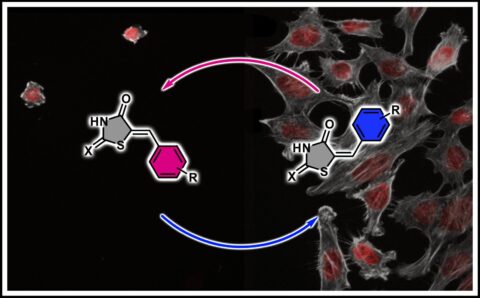Team of researchers at FAU develops new class of light-sensitive molecules
Controlling cell dynamics using light
Diseases usually develop in a certain organ or in certain tissues in the human body. However, medication is usually given for the entire body and not just where the disease is located. This can lead to damage to healthy tissue and undesired side effects. This is the reason why photopharmacology aims to develop molecules that are activated using focused exposure to light thus limiting their effect to a small area. In a joint project at Friedrich-Alexander-Universität Erlangen-Nürnberg (FAU), the research groups of Prof. Dr. Henry Dube, Chair of Organic Chemistry I and Prof. Dr. Esther Zanin, Professorship for Experimental Molecular Cell Dynamics, have now developed light-controlled rhodanines that can be used to trigger cell death in cancer cells using light. The group of scientists has published their results in the Journal of the American Chemical Society.
These newly-developed light switches, known as oxo-rhodanines, are light-sensitive molecules of dye that react to exposure to UV light or blue light. They were synthesized and characterized by Prof. Dube’s working group. During this process, the scientists discovered that the new molecules undergo reversible structural, chemical and physical changes as a reaction to light exposure. Like a switch that switches a light on and off, it is possible to switch these molecules between two different states by exposing them to light.
Both states, known as Z isomers and E isomers, are largely dependent on the chemical compounds contained in the molecules. The chemical composition of the isomers is the same, but their spatial structure varies, which means, for example, that the Z isomers of the photoswitch are yellow and the E isomers are orange or red. Another difference lies in the stability of the switching states, which is more pronounced in the Z isomer than the E isomer. In addition, whereas the E isomer cannot interact with specific proteins due to its structure, the Z isomer has this ability.
In their article, the researchers demonstrate that the above properties can be easily modified and set by replacing an existing sulfur atom in the rhodanine photoswitch with an oxygen atom. The stability of the switching states in the resulting oxo-rhodanines are significantly improved. The presence of the sulfur and oxygen atoms is also important in order to facilitate interaction with other molecules and proteins.
Molecular photoswitches in cancer cells
Since rhodanines can influence the way proteins operate, cancer research is an important application for this technique and the interaction of both isomers with the signal protein PIM-1 has now been analyzed.
Researchers in Prof. Zain’s working group investigated the effect of the developed oxo-rhodanines on human cancer cells and proved that controlling the activity of the oxo-rhodanines with light can influence the survival of cancer cells. To do so, they cultured cancer cells and treated them either with the Z or the E isomers to find out in which state the molecules are biologically active.
Cell death occurred in the cancer cells in the experiment with the Z isomer. The reason behind this is the key-lock principle, which states that the Z isomer fits into the binding site of the PIM-1 kinase (an enzyme of the signal protein), thus inhibiting its activity and triggering cell death. This did not occur with the cancer cells treated with E isomers. They survived since the E isomer could not bind the protein as its “key” did not fit.
In the next step, cell groups were treated either with the inactive E isomer or the active Z isomer and this time additionally exposed to UV light for 10 seconds. Exposing the cells with Z isomers to UV light led to conversion to the inactive E isomer and almost all cells survived. Conversely, irradiation of cells that had first been treated with E isomer led to conversion to an active Z isomer and thus to the death of almost all cells present. In this way, the researchers demonstrated that the biological activity of the rhodanines can be switched on and off using light and that light signals can therefore be used for controlled cell death in cancer cells.
Light-sensitive molecules for a wide range of applications
The results of both teams’ investigations identify rhodanine-based dyes as new precision tools for controlling cell signals and cell death using light.
In medicine, this work can now be further developed in order to trigger cell death through light in organs affected by disease, such as cancer and inflammation. The potential range of applications for light-controlled rhodanine molecules is much wider and could, for example, also be used for manufacturing solar cells or rechargeable lithium-ion batteries.
Link to the study: https://doi.org/10.1021/jacs.3c07710
Further information:
Prof. Dr. Henry Dube
Chair of Organic Chemistry I
Prof. Dr. Esther Zanin
Professorship for Experimental Molecular Cell Dynamics
